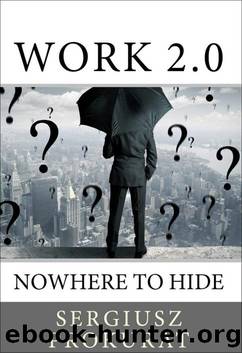Work 2.0. Nowhere to hide by Prokurat Sergiusz

Author:Prokurat, Sergiusz [Prokurat, Sergiusz]
Language: eng
Format: epub
Published: 2013-11-20T05:00:00+00:00
Chapter 5: An Individual in the World of Work 2.0
How does someone navigate this complicated and technologically nuanced World 2.0? Not everyone finds it easy. Peter Fingarin, in his report entitled âWork 2.0â, finds that in this thicket of information we receive we actually experience Information Overload 2.0, which prevents many people from keeping up with assimilating new data (Fingar, 2007b). Fingar points out in his analysis that office workers often spend 2 hours a day reading and sorting email they receive in their inbox. The quest for effectiveness deprives us of time for many things. The constant rush crowds out personal time and space in World 2.0 and this time can no longer be dedicated to interpersonal relations, deep thinking, or even a rational plan for our career. This issue has also been taken up by philosophers. Once, Zygmunt Bauman notes in his book âThe Art of Lifeâ,a career choice was about accepting a template of sorts which was a one-off choice for oneâs âlife projectâ, which then had to be fulfilled (Bauman, 2008). Yet today you have to be flexible and chase the ever-changing reality. Despite increasing possibilities of self-expression and choosing your career path we paradoxically run a greater risk of ânavigating in the mistâ âorganisations offer workers far less support than they did a few decades ago. Nevertheless, this is good news for the best, who can enjoy unprecedented transparency of the labour market and, in effect, a greater chance of branding themselves as an accomplished specialist, dedicated worker or expert.
Individuals unaware of the transformation will struggle in the world of Work 2.0. A time of permanent unemployment for a large part of society is approaching--a time when working will become a luxury, especially in the case of well-paid jobs. Many organisations now use contractors or agencies, and as a result these new employees make considerably less than they did before and they usually donât enjoy any benefits. Thatâs just the shape of the new world economy.
People have less money in their pockets. Working family members who make up an average household make less in real terms than they did in 2000 as shown by Figure 9. While the US economy has recovered modestly since the financial crisis, median household income is still below its pre-2007 level. For workers this means adhering to the idea of âmore for lessâ! If we also factor in rising unemployment the conclusions are evident â the individualâs lot isnât easy in the world of Work 2.0. This is a problem not only specific to the US but present all around the world. For example in England, real wages have fallen in 36 of the 37 months since May 2010, according to new data from June 2013. The figures suggest the average worker will have lost the equivalent of £6,660 in that period (Pickard and Rigby, 2013). In the document "Global Employment Trends 2013" the ILO points out that in the fifth year of the crisis there isnât much positive information (Ernst et al.
Download
This site does not store any files on its server. We only index and link to content provided by other sites. Please contact the content providers to delete copyright contents if any and email us, we'll remove relevant links or contents immediately.
What's Done in Darkness by Kayla Perrin(25490)
Shot Through the Heart: DI Grace Fisher 2 by Isabelle Grey(18208)
Shot Through the Heart by Mercy Celeste(18151)
The Fifty Shades Trilogy & Grey by E L James(17767)
The 3rd Cycle of the Betrayed Series Collection: Extremely Controversial Historical Thrillers (Betrayed Series Boxed set) by McCray Carolyn(13179)
The Subtle Art of Not Giving a F*ck by Mark Manson(12895)
Scorched Earth by Nick Kyme(11821)
Stepbrother Stories 2 - 21 Taboo Story Collection (Brother Sister Stepbrother Stepsister Taboo Pseudo Incest Family Virgin Creampie Pregnant Forced Pregnancy Breeding) by Roxi Harding(11008)
Drei Generationen auf dem Jakobsweg by Stein Pia(10207)
Suna by Ziefle Pia(10176)
Scythe by Neal Shusterman(9249)
International Relations from the Global South; Worlds of Difference; First Edition by Arlene B. Tickner & Karen Smith(8599)
Successful Proposal Strategies for Small Businesses: Using Knowledge Management ot Win Govenment, Private Sector, and International Contracts 3rd Edition by Robert Frey(8404)
This is Going to Hurt by Adam Kay(7680)
Dirty Filthy Fix: A Fixed Trilogy Novella by Laurelin Paige(6444)
He Loves Me...KNOT by RC Boldt(5795)
How to Make Love to a Negro Without Getting Tired by Dany LaFerrière(5366)
Interdimensional Brothel by F4U(5298)
Thankful For Her by Alexa Riley(5148)
